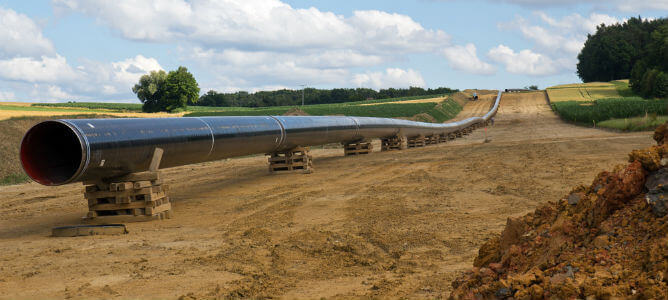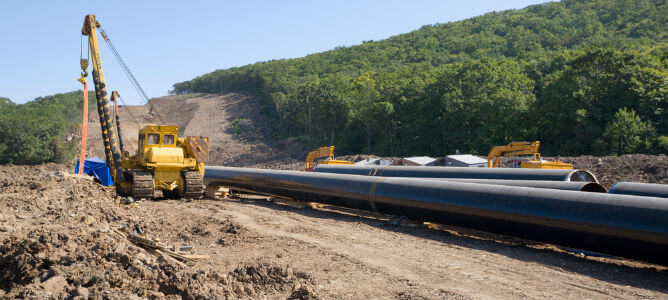
Pipeline Drying and Dewatering – After Hydrotesting & New Construction
Pipeline construction and pipeline repairs are major projects that require detailed steps before a pipeline can be put into service. One step that can be overlooked until late in the project is pipeline drying. Why is this process so important and what options are available for effective pipeline drying?
This article will outline effective measures used to achieve pipeline drying and dewatering.
Importance of Pipeline Drying
Hydrostatic testing companies can help operators verify the safety and suitability of their pipeline network for the intended products. However, the process will leave residual water within the tested channels.
Water retained within pipelines after hydrotesting will cause rapid corrosion as well as alter the purity of fluid channeled through them. Consequently, all operators must invest in pipeline drying after hydrotesting to ensure their pipelines function as efficiently as possible.
Contact NiGen if you’re in need of trusted pipeline cleaning services.
6 Common Methods of Pipeline Drying
Outlined below are five effective methods of achieving pipeline dewatering and drying.
- Pipeline Drying with Nitrogen Gas
- Hot Air Drying
- Chilled Air Drying
- Vacuum Drying
- Pigging/Swabbing
- MEG Drying
Read through the specifications of each technique to determine which options suits your operation.
1. Pipeline Drying with Nitrogen
Gaseous nitrogen possesses suitable chemical properties that make it suitable for pipeline drying including its inert, non-reactive nature which makes it very stable. As a result, pipelines primed with nitrogen gas are less likely to have explosive accidents. Further nitrogen gas will displace oxygen, water vapor, and other impurities that can erode the pipelines or alter the quality of their contents.
The nitrogen purging process typically involves feeding nitrogen gas into a selected pipeline at one end. The propulsive force and chemical nature of the gaseous nitrogen are sufficient to push residual water and impurities through the pipeline’s length and expel them through an exit port at the other end.
The drying process is deemed complete when a difference of at least 10°F between the feed gas dewpoint and outlet gas dewpoint is obtained.
2. Hot Air Pipeline Drying
The procedure for hot air conduit drying is like pipeline dewatering using nitrogen. The major difference is the use of heated air supplied by an industrial air compressor. Introducing heated air into a wet pipeline will cause rapid water vapor formation.
This evaporated moisture can then be conducted to the opposite end of the pipeline where an exit port is located. Hot air pipeline tests can be monitored using hygrometers or transmitters that automatically detect differences between the inlet and outlet air dewpoints.
3. Chilled Air Drying
Another effective technique for eliminating moisture from pipelines following hydrostatic testing is the use of very dry chilled air. Highly powerful ventilators can be used to drive a stream of very dry cold air through a pipeline to eliminate residual water.
This method involves the use of industrial chillers to cool the air to sub-zero temperatures before use to facilitate efficient moisture removal. As with other drying procedures, dewpoint monitoring is conducted to determine the completeness of the drying cycle.
4. Vacuum Drying
In vacuum drying, the selected pipelines are completely sealed off at both ends with a single port connected to a vacuum device. The attached vacuum system is used to remove air and residual water from the pipelines after a stable vacuum pressure is achieved.
Operators can monitor variations in dew points during the drying process to accurately determine completion. For example, the dewpoint readings will initially stabilize as water is being removed from the system, then drop once all the moisture has been vacuumed out. Additionally, automated devices can also provide accurate data on the drying process.
5. Pigging and Swabbing
Pipeline pigging and swabbing is a mechanical method of pipeline drying. The swabbing process is conducted using a device called a pig which is made of foam or other suitable polymer materials.
A pig is introduced at one end of the pipeline to be dried and driven along the entire length of the channel to the other end. Pigs devices are usually manufactured to fit the internal diameter of the pipelines they dry with a larger contact area between them and the inner walls of the pipelines.
Pigging/swabbing is very effective at removing residual moisture from hydrotesting as well as any particulate impurities present. If you’re searching for experienced pipeline maintenance companies, contact NiGen about their services today.
6. Mono Ethylene Glycol (MEG) Drying
This is a chemical method of pipeline drying that exploits the hygroscopic properties of mono ethylene glycol to achieve moisture removal. This chemical compound is propelled through a pipeline’s lumen from one end to the other using dry air or natural gas as a driving agent.
MEG drying eliminates any water leftover from hydrostatic testing reducing the chance of rapid corrosive damage to treated pipelines and boosting their useful life spans.
Due to its total anti-hydration properties, MEG proving is particularly beneficial for operators with pipeline networks running through cold environments. With the absence of water in their pipes, the chance of freezing, contaminant accumulation, and channel blockage is eliminated.

Use a Nitrogen Generator for Nitrogen Purging for Cost-Savings
There are several advantages to the use of nitrogen in pipeline drying. Having a nitrogen generator onsite can allow the nitrogen to be used for pneumatic pipeline pressure testing. Then the same nitrogen generator can be used to purge the line and dry it in preparation for commissioning. After the dewatering has been completed, nitrogen can be used to propel a pig train through the line.
If the pipeline will be used for hydrocarbons, the nitrogen can pack the line to ensure that the system has been purged of any oxygen since it is vital that the hydrocarbons be kept separate from anything flammable. Using nitrogen allows a single piece of pipeline drying equipment to be used for multiple steps in the process to prepare the pipeline for commissioning. That can simplify the process while reducing the manpower and costs associated with coordinating the acquisition, delivery, and operation of process equipment.
Contact NiGen today for more information.
